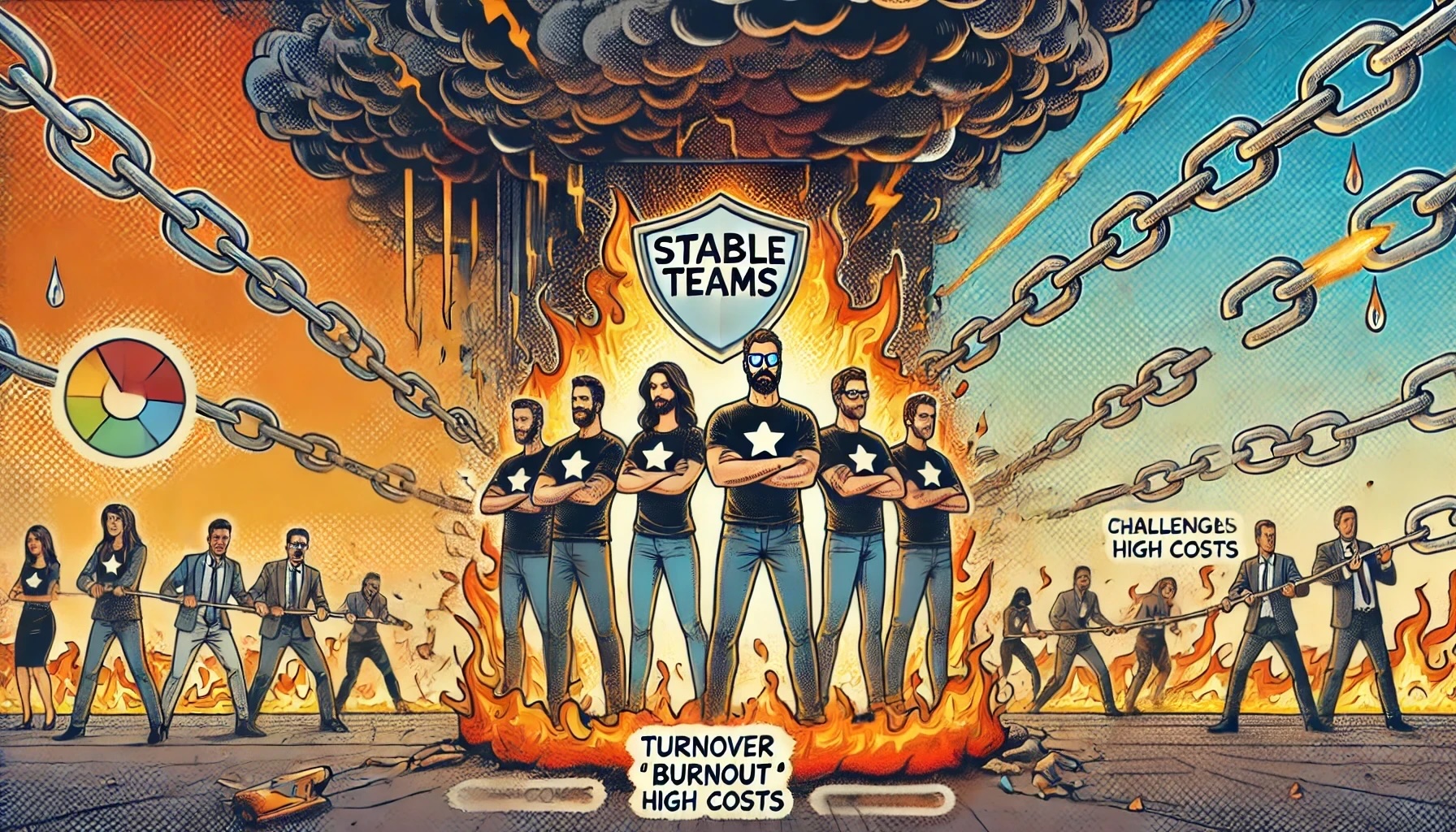SaaS outsourcing options: nearshore or offshore

Introduction
Hiring top-tier developers locally can strain budgets, especially for startups and growth-stage companies. Rising salaries, retention challenges, and the expenses of maintaining in-house teams can push development beyond financial reach. So, it's time to think about SaaS outsourcing.
Nearshore and offshore development offer a practical alternative, balancing cost savings with access to skilled talent. This article explores how nearshore and offshore solutions can optimize SaaS development costs without compromising product excellence, ensuring long-term scalability and business success.
Agile discovery and prototyping costs in SaaS: A smart investment
- Cost-effective SaaS outsourcing: Nearshore vs Offshore solutions — you are here
- How to develop the best ERP SaaS solutions for small companies
- How to use cross-border eCommerce SaaS solutions to break the borders on your benefit
How nearshore and offshore SaaS outsourcing cut costs for startups

Cost savings compared to in-house teams
Hiring nearshore and offshore developers can dramatically reduce expenses compared to building in-house teams. Here’s how:
- Lower developer rates. Nearshore developers in Latin America charge $40-$75 per hour, far less than U.S. developers averaging $100-$150 per hour. Offshore teams in regions like India or Eastern Europe offer even lower rates, sometimes as low as $25 per hour.
- Reduced overhead costs. No need for office space, employee benefits, or expensive onboarding processes, resulting in 50-70% savings on operational expenses.
- Flexible scaling. Startups can scale teams up or down as needed, avoiding long-term hiring commitments and reducing payroll risks.
Proximity and time zone advantages
Proximity and time zone alignment play a significant role in seamless collaboration:
- Nearshore proximity. Countries like Mexico, Colombia, and Poland share overlapping business hours with the U.S. and Europe, enabling real-time collaboration.
- Faster communication. Fewer time zone gaps mean quicker responses, enabling daily standups and sprint planning, crucial for Agile development.
- Reduced travel costs. Nearshore developers are just a short flight away, simplifying in-person meetings or project kick-offs when needed.
Skilled talent pools in nearshore and offshore regions
Access to a vast global talent pool ensures SaaS startups can find highly specialized developers:
- Tech hubs by region.
- Latin America. Known for React, Node.js, and cloud developers.
- Eastern Europe. Home to skilled Python, Java, and cybersecurity experts.
- Asia. Renowned for full-stack development and AI/ML expertise.
- Quality with cost savings. Competitive rates don’t compromise quality — top developers with relevant certifications and project portfolios are readily available.
Reducing turnover risks in SaaS outsourcing
Talent retention is often a hidden cost in SaaS development. Nearshore and offshore outsourcing reduces this risk through:
- Stable teams. Experienced agencies provide well-supported teams with lower turnover rates than independent freelancers.
- Cultural and communication fit. Nearshore developers share similar work cultures, boosting team cohesion and reducing project disruption.
- Built-in talent management. Outsourcing partners handle HR, payroll, and training, saving SaaS startups from administrative headaches.
Balancing budget and quality within SaaS outsourcing: Prioritizing features for MVPs
When building a SaaS MVP, every decision counts. The right feature prioritization ensures you balance budget constraints while delivering a high-quality product. Here’s how to do it strategically:
Understand the MVP concept

An MVP is the most basic version of a product with just enough features to attract early adopters and validate market demand. This approach minimizes development costs while providing valuable user feedback for future iterations.
Prioritize core features
- Identify must-haves. Focus on features that solve users’ primary pain points. Use customer interviews, competitor analysis, and market research to validate what matters most.
- Use a tiered feature list. Categorize features into three tiers:
- Must-have. Core functionalities essential for product launch.
- Nice-to-have. Features that enhance user experience but aren’t critical.
- Future enhancements. Add-ons that can wait until after the MVP launch.
Implement cost management strategies
- Adopt Agile development. Use Agile methodologies to break development into sprints. This keeps the process flexible and prevents feature creep, ensuring budget-friendly, incremental progress.
- Optimize the tech stack. Choose proven, cost-effective technologies with strong community support to avoid expensive licensing fees or specialized developer needs.
- Leverage outsourcing. Outsource development to nearshore or offshore teams with relevant expertise to reduce operational costs while maintaining quality.
Use iterative development and feedback loops
- Launch early, iterate fast. Release a working MVP as soon as possible to gather real-world feedback. Iterations guided by user insights can improve product quality without overextending the initial budget.
- Monitor key metrics. Use analytics tools like Mixpanel or Google Analytics to track feature engagement, retention rates, and usage patterns. This data helps determine which features should be improved or expanded next.
Case studies: Cost savings through nearshore and offshore SaaS outsourcing
Nearshore and offshore development have proven transformative for SaaS companies at various growth stages — startups, scaling businesses, and enterprises. Below are real-life case studies highlighting successful implementations across different SaaS scenarios.
SaaS startup accelerating MVP development
A U.S.-based FinTech SaaS startup needed to launch its minimum viable product (MVP) quickly while managing a tight budget.
Challenge. Local developer rates were prohibitively high, and in-house recruitment would have delayed the launch.
Solution. The startup partnered with a nearshore team in Latin America, leveraging similar time zones for seamless collaboration and daily stand-ups.
Outcome:
- Time savings. The MVP was launched three months ahead of schedule.
- Cost savings. Approximately $50,000 was saved in development costs.
- Business impact. Early market entry secured key investors and reduced operational overhead by 40%.
Growth-stage SaaS scaling teams flexibly
A Canadian EdTech SaaS company needed to scale its engineering team rapidly to meet increasing customer demands.
Challenge. Local hiring was time-consuming and expensive, limiting the company’s ability to roll out new features quickly.
Solution. The company built a hybrid development model by hiring nearshore developers in Eastern Europe and South America. Nearshore teams worked on the frontend, while offshore developers handled backend services.
Outcome:
- Cost savings. Development expenses were reduced by 50%.
- Faster releases. Time-to-market for new features was reduced from six months to three.
- Team expansion. Successfully onboarded 10 developers without long-term hiring commitments.
Enterprise SaaS outsourcing modernization cost-effectively
A U.S.-based healthcare IT SaaS company needed to modernize its legacy system while ensuring HIPAA compliance.
Challenge. Hiring specialized healthcare software developers locally would have doubled their projected costs.
Solution. The company partnered with an offshore development team in Eastern Europe with expertise in regulatory compliance and healthcare SaaS.
Outcome:
- Cost savings. Modernization was completed 40% under budget.
- Compliance assurance. Full HIPAA compliance was maintained.
- Operational impact. Enhanced platform reliability and scalability.
SaaS platform localizing products for global markets
A U.S.-based SaaS collaboration platform sought to expand into emerging markets by offering localized versions of its product.
Challenge. Building in-house teams in each target region would have required significant investment and complex logistics.
Solution. The company launched nearshore development hubs in Latin America and Southeast Asia to create customized versions of its software.
Outcome:
- Faster localization. Localized versions were developed 35% faster.
- Cost reduction. Total project costs decreased by 45%.
- Market expansion. Successfully entered three new international markets within 12 months.
FinTech SaaS enhancing AI-powered features
A European FinTech SaaS startup aimed to integrate AI-powered analytics into its product but lacked local talent proficient in machine learning.
Challenge. Recruiting experienced AI engineers locally would have increased costs by 60%.
Solution. The company partnered with a nearshore AI development team in South America, known for its deep learning expertise.
Outcome:
- Product enhancement. The AI-powered analytics module launched within six months.
- Customer retention. Customer retention increased by 25%.
- Budget efficiency. The project was completed 40% under budget, enabling reinvestment in marketing and product expansion.
SaaS eCommerce platform modernizing with cloud migration
A Canadian eCommerce SaaS platform needed to migrate its monolithic application to a cloud-based microservices architecture.
Challenge. Cloud migration required experienced developers, but local hiring costs were unsustainable.
Solution. The SaaS outsourced cloud migration to an offshore development team in India, specializing in AWS and Kubernetes.
Outcomes:
- Cost savings. Migration expenses were reduced by 45%.
- Performance improvement. Platform performance improved by 30%.
- Operational efficiency. The offshore team provided round-the-clock support, ensuring minimal downtime and a seamless transition.
Key Insights from the case studies
- Cost savings. Companies achieved savings of up to 70% by leveraging nearshore and offshore development models.
- Faster market entry. MVPs were developed 30%-50% faster, enabling earlier market launches.
- Enhanced team flexibility. Businesses scaled development teams on demand without long-term commitments.
- Improved product quality. Access to specialized global talent ensured high-quality products that met industry standards.
- Compliance and security. Offshore teams with regulatory expertise maintained compliance with industry regulations, including GDPR, HIPAA, and PCI-DSS.
Recommendations for implementing nearshore and offshore SaaS outsourcing

Successfully implementing nearshore and offshore development strategies can be transformative for SaaS companies. Whether you’re a startup building your MVP, a scaling business expanding your development team, or an enterprise modernizing legacy systems, here are practical recommendations to ensure seamless collaboration, cost savings, and high-quality outcomes.
1. Strategic vendor selection
Actionable steps:
- Define core goals. Establish your project’s scope, budget, timeline, and deliverables.
- Evaluate vendors. Consider technical expertise, cultural compatibility, and industry certifications (e.g., ISO, CMMI).
- Send detailed RFPs. Include expected outcomes, service-level agreements (SLAs), and project milestones.
- Shortlist vendors. Conduct in-depth technical interviews, management assessments, and portfolio reviews.
Why it matters. Selecting the right vendor minimizes risks, ensures technical alignment, and builds long-term project success.
2. Clear contractual and legal framework
Actionable steps:
- Create detailed contracts. Include deliverables, deadlines, performance benchmarks, and penalties for delays.
- Sign data security agreements. Use IP protection clauses, NDAs, and data residency compliance protocols.
- Define dispute mechanisms. Establish conflict resolution protocols like arbitration or mediation.
Why it matters. Well-defined legal agreements reduce ambiguity, protect intellectual property, and ensure regulatory compliance.
3. Project onboarding and kickoff
Actionable steps:
- Plan onboarding. Organize team introductions, tool setup, and knowledge-sharing sessions.
- Define roles. Clearly assign responsibilities and ownership for every team member.
- Conduct knowledge transfer. Hold training workshops and domain-specific onboarding.
- Set up tools. Use project management tools like Jira, Trello, and Asana for task tracking.
Why it matters. Proper onboarding accelerates project timelines and builds team alignment from day one.
4. Communication and collaboration framework
Actionable steps:
- Use unified communication platforms. Tools like Slack, Zoom, and MS Teams enable instant messaging and video calls.
- Schedule meetings. Plan daily check-ins, sprint reviews, and retrospectives.
- Centralize documentation. Store project files in platforms like Confluence, Notion, or Google Workspace.
- Assign a single point of contact (SPOC). Designate dedicated project managers to streamline communication.
Why it matters. Frequent, clear communication prevents misunderstandings and keeps projects on track.
5. Agile development practices
Actionable steps:
- Adopt agile methodologies. Use Scrum or Kanban for task management and sprint-based releases.
- Implement CI/CD pipelines. Use Jenkins, GitHub Actions, or GitLab CI/CD for automated deployments.
- Conduct sprint reviews. Regularly assess progress, resolve blockers, and prioritize upcoming tasks.
Why it matters. Agile methodologies reduce development cycles, improve adaptability, and boost product quality.
6. Quality assurance and performance monitoring
Actionable steps:
- Define quality metrics. Track KPIs like defect rates, time-to-resolution, and release frequency.
- Conduct code reviews. Schedule code reviews and audits at the end of every sprint.
- Automate testing. Use Selenium, Cypress, or Azure Pipelines for continuous testing.
- Use performance dashboards. Monitor system performance with New Relic, Datadog, or Prometheus.
Why it matters. A proactive QA strategy ensures reliable, bug-free releases and minimizes costly errors.
7. Risk mitigation and issue resolution
Actionable steps:
- Maintain a risk register. Document potential risks, their likelihood, and mitigation strategies.
- Establish disaster recovery plans. Set data backup protocols and cloud-based failover systems.
- Conduct root cause analysis. Use RCA tools to identify and resolve recurring technical issues.
Why it matters. Risk management reduces service disruptions and ensures project continuity.
8. Cultural integration and team engagement
Actionable steps:
- Provide cultural sensitivity training. Train both teams on work culture, communication styles, and etiquette.
- Organize team-building events. Host regular virtual team-building activities and informal check-ins.
- Implement feedback mechanisms. Use surveys and review sessions to gather improvement suggestions.
Why it matters. Culturally aligned teams collaborate better, communicate more effectively, and produce higher-quality work.
9. Post-project evaluation and continuous improvement
Actionable steps:
- Conduct project review sessions. Assess project timelines and deliverables.
- Hold lessons-learned workshops. Identify project strengths, weaknesses, and best practices.
- Track vendor performance reports. Monitor key metrics like delivery speed, code quality, and customer satisfaction.
- Engage top-performing vendors. Extend contracts with high-performing vendors to ensure service continuity.
Why it matters. Post-project evaluations help refine future processes, improve vendor selection, and enhance service quality.
Best practices of SaaS outsourcing summary
| Category | Best practice | Recommended tools |
| Vendor selection | Evaluate portfolios & certifications | Upwork, Clutch, GoodFirms |
| Legal compliance | Ensure GDPR, NDAs, IP protection | DocuSign, TrustArc |
| Project management | Use centralized PM tools | Jira, Trello, Asana |
| Communication | Use unified messaging platforms | Slack, Zoom, MS Teams |
| Quality assurance | Automate testing & code reviews | Jenkins, Selenium, GitHub CI |
| Performance monitoring | Use real-time performance trackers | New Relic, Datadog, Prometheus |
| Risk management | Maintain a risk register | RiskWatch, Monday.com |
| Cultural integration | Host virtual team-building events | MS Teams, Kahoot, Mentimeter |
| Post-project evaluation | Conduct project reviews & audits | Custom review templates |
Final recommendations
- Start small. Begin with a pilot project to test the partnership before scaling.
- Create multi-year strategies. Plan long-term engagements with periodic reviews.
- Foster transparent relationships. Build trust through open communication and regular updates.
- Invest in automation. Use DevOps practices to standardize processes and reduce manual tasks.
Monitor continuously. Use dashboards and alerts for real-time project tracking and team productivity.
Egor Kaleynik
IT-oriented marketer with B2B Content Marketing superpower. HackerNoon Contributor of the Year 2021 Winner – MARKETING. Generative AI enthusiast.
Featured in: Hackernoon.com, Customerthink.com, DZone.com, Medium.com/swlh
More info: https://muckrack.com/egor-kaleynik